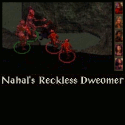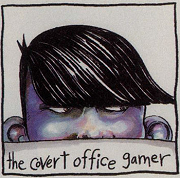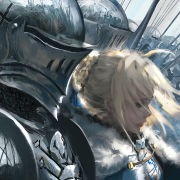|
WiredNavi posted:I suppose that's a good point. I remember much of my time spend thinking about 4e characters - even more than thinking about powers and feats - was thinking about which magic items I would need at what levels and in what order of priority so I could badger the DM into putting them into the game for me. In 3/3.5 they were clearly cool and necessary and you needed a certain amount of them to function, but it never felt like it was a good idea to build my character around acquiring a complicated series of un-connected magic items which would all synergize when I got the 5th one. I think it's that in 3.5, a major chunk of magic items were devoted the "Big Six" of stat boosters that you needed just as a matter of course because the math broke down even more if you didn't. Stuff like magic weapons, magic armor, save boosters, etc. Then that leftover cash could be spent on whatever you wanted. In 4e, you had the Big Three magic item slots, weapon, armor, neck, and every magic item in those slots gave you the bonuses from before. Since your budget opened up a ton, that meant that there was a lot more to choose from. And there were a fuckton of magic items. Want a build focused on charge attacks? You can fill every slot with a magic item that makes your charge attacks better. Focus on basic attacks? Ditto. Focus on ice spells? Sure, just got to netdeck the build or comb through the books yourself. So when people say you need magic items in 3.5, they mean "or my numbers would be so low that I'd die, because I'm not a druid/wizard/cleric". When people say you need magic items in 4e, it's "or my build and character concept won't work."
|
|
|
|

|
| # ? Jun 8, 2024 23:20 |
|
Quadratic_Wizard posted:I think it's that in 3.5, a major chunk of magic items were devoted the "Big Six" of stat boosters that you needed just as a matter of course because the math broke down even more if you didn't. Stuff like magic weapons, magic armor, save boosters, etc. Then that leftover cash could be spent on whatever you wanted. Right, but the thing in 4E is that you are looking for specific items, often in almost every slot, to enable a build or make that build as strong as it could be. Random treasure was almost worthless, your poo poo needed to be custom so you could get/keep your godly build. A good example is the "charge kit," where you had weapon, hat, boots, and neck slot, maybe even a little more. None of which were really negotiable since charging all the time is one of the highest-damage options. Name Change fucked around with this message at 23:30 on Sep 21, 2015 |
|
|
|
4E treasure really did go way too hard on the +x when you y stuff. There was loads of really neat stuff in there but it was badly overshadowed by all the ways to just pile on the damage/accuracy/passive effects. See also:feats
|
|
|
|
Quadratic_Wizard posted:So when people say you need magic items in 3.5, they mean "or my numbers would be so low that I'd die, because I'm not a druid/wizard/cleric". When people say you need magic items in 4e, it's "or my build and character concept won't work." I don't see anything to love about either of those statements. Also I felt like 4E reduced the actual excitement of finding magic treasure. It was either 'Finally, I wish my DM had given this item I was expecting sooner' or 'what is this, nobody wanted this thing and none of us have room for it in our builds'. The expected and necessary items were the only worthwhile ones; it was always either a disappointment or anot her thing I had already planned on.
|
|
|
|
I'm going to spoil the best part of OOTA for you all. Behold the fat dragon.
|
|
|
|
Is it an earthquake dragon?
|
|
|
|
Yeah, that looks like a Chaud.
|
|
|
|
4e should probably be played with inherent bonuses anyway.
|
|
|
|
Inherent bonuses and "Pick X level-appropriate item effects" to represent their chosen gear, then throw all gold tracking out the window and go kill a few gods.
|
|
|
|
Andrast posted:4e should probably be played with inherent bonuses anyway. Only probably?
|
|
|
|
Andrast posted:4e should probably be played with inherent bonuses anyway.
|
|
|
|
Splicer posted:Doesn't solve the problem of cool things like "throw your hammer like Thor" trying to compete with boring but too good not to take stuff like "do a hunk of extra damage on every attack" or "always have combat advantage". Or the crazy variance between optimizing Class/Race/PP combo A and Class/Race/PP combo B. I played a half-elf Vestige Pact warlock. My friend played a Tiefling wizard with lots of fire spells. Guess which of us contributed more? It's not caster superiority but there sure seemed to still be a huge imbalance between classes. I enjoyed the crunchy tactical stuff, I just think that a lot of the issues with 4E get glossed over when comparing it to 5E because they're very different issues.
|
|
|
|
WiredNavi posted:I don't see anything to love about either of those statements. Also I felt like 4E reduced the actual excitement of finding magic treasure. It was either 'Finally, I wish my DM had given this item I was expecting sooner' or 'what is this, nobody wanted this thing and none of us have room for it in our builds'. The expected and necessary items were the only worthwhile ones; it was always either a disappointment or anot her thing I had already planned on. I felt 3.0 crushed the actual excitement of finding magic treasure. Magic items were something you could make rather than loot that was tied to the circumstance of your obtaining it. But then other than the original wizard (whose spells were findable magic items), the excitement was always low in D&D compared to many other games because +X swords or armour fundamentally are not interesting.
|
|
|
|
WiredNavi posted:Or the crazy variance between optimizing Class/Race/PP combo A and Class/Race/PP combo B. I played a half-elf Vestige Pact warlock. My friend played a Tiefling wizard with lots of fire spells. Guess which of us contributed more? It's not caster superiority but there sure seemed to still be a huge imbalance between classes. Splicer fucked around with this message at 00:50 on Sep 22, 2015 |
|
|
|
neonchameleon posted:I felt 3.0 crushed the actual excitement of finding magic treasure. Magic items were something you could make rather than loot that was tied to the circumstance of your obtaining it. But then other than the original wizard (whose spells were findable magic items), the excitement was always low in D&D compared to many other games because +X swords or armour fundamentally are not interesting. I'm not sure that having them be craftable made them less interesting because the resources that needed to be sunk to make anything interesting were pretty intense. My favorite memories of 3.5 are from playing an artificer wizard with all his feats in item creation - but he was significantly less useful in general than a wizard who'd used their feats in a more optimized fashion, like spell penetration (not even counting all the ridiculous splatbook feats.) That said, +x weapons are totally dull and there's not much to be done about it. I do like that 5E suggests ways to spice up magic items narratively, but the way they did it is purely Gygax Table territory. Splicer posted:I definitely wouldn't say they're glossed over, since that implies they're being deliberately avoided, but you're right in that they're often just not relevant to discussion of 5E. Most of 4Es actual problems were either bathwater that went out with the baby or holdovers from 3.X. 4E "solved" the magic item problem by making them an assumed part of your character, which brought in new problems. 5E "solved" it by doubling down on 3.X's conceit of them being optional, while not actually fixing the underlying reasons why this wasn't true. 4E's feats were everything wrong with 3.X's feats but more so, 5E's feats are actually interesting mini character addons that cost ability scores for some some godforsaken reason. Skill challenges were, at best, a poor implementation of a potentially good idea. 5E's skill system is 3.x's with less bonuses but literally copy-and-pasted DCs. If 5E was an actual successor to 4E instead of just sharing a common ancestor then there might be a point in bringing them up, but for the most part it's about as useful as bringing up the speedster issues in Mutants and Masterminds. That's a good way of putting it. 5E needs a lot of fixing. I just don't think that other editions needed significantly less, and I personally really like a lot of the things it does.
|
|
|
|
AlphaDog posted:Yeah, for sure, but it took me well over a year of regular play to get to a place where I could reliably make good encounters. And then I'd have to rethink things every time a new splatbook or campaign guide hit the table. If you plan on playing for a long while 1e/2e eventually becomes pretty effortless to run. (I agree that starting from square-one it takes some effort though.)
|
|
|
|
FRINGE posted:and (based on posts here) most people required computer assistance to handle 4e. It's more that the option was there and for a crunchy game like D&D it was incredibly handy. If there had been a 3.5 equivalent it'd be the same way, and if there were a 5E equivalent it'd be the same as well. So it's not required at all, but goddamn is it appreciated to have. Like, there's this amazing toolset over there that makes all jobs involving the game easier. I don't tend to send regular mail, either, and I prefer to use email. Does this mean I 'require' email? No, the other option is still there and I can use it just fine, but why would I?
|
|
|
|
FRINGE posted:and (based on posts here) most people required computer assistance to handle 4e. Splicer fucked around with this message at 02:41 on Sep 22, 2015 |
|
|
|
You're totally right that 1e/2e ends up in your head and is hard to dislodge. BECMI Basic does the same thing and steps you through the learning process really well. While I'm sure I could run something approximating 2e without relying heavily on the books, I could run something very close to Basic without looking at the rules at all. I was gonna say I want the to-hit table, but I can still do those in my head, so... I did a lot of 4th ed without any computer stuff at all. That said, the character builder made it super super easy for a new player to get started, what with doing all the calculations and filling the sheet for you. That same stuff saved a fair bit of time and dull messing around for experienced players too. Not using it is totally doable, but as dumb as deciding that indexes and cross-referencing are a crutch for weak minds and so you will ignore them. A 4e style character builderfor 2e that included all the splats and optional campaign stuff would be a magical piece of software.
|
|
|
|
FRINGE posted:I was still thinking about this, and its worth people knowing that at some point 1e/2e lives in your head and you can just kind of run with it. 3e was a bloated numbers mess and (based on posts here) most people required computer assistance to handle 4e. 4E was dead simple. The computer assistance was them magically compressing every single splat book into an easy to use system that made character creation about as smooth as building a character in a cRPG. Not because it was a "dumbed down" computer game either. It just had a rational and logically consistent framework that was a dead simple dream to use when a piece of software was presenting every option from a mountain of splat books. If you wanted to sit there and cross reference the books by hand, it worked just as well. But why would you want to? The real problem with 4E was that it was in some respects too effortless. People took forever to take their turn because they actually understood everything they could do, and got stuck in analysis paralysis, which got tarred and feathered as being over complicated.
|
|
|
|
WiredNavi posted:My favorite memories of 3.5 are from playing an artificer wizard with all his feats in item creation - but he was significantly less useful in general than a wizard who'd used their feats in a more optimized fashion, like spell penetration (not even counting all the ridiculous splatbook feats.) There's a reason that the Artificer class from ECS managed to claw it's way up to the big boy tiers with all the good 9/9 casters, and it's not the native access to 6/9 casting it has.
|
|
|
|
Cyclomatic posted:4E was dead simple. Except for the mess of character options and trap feats, and that was just in the early books.
|
|
|
|
Nihilarian posted:I can't believe I'm seeing someone claim Spell Penetration is more optimized than literally any Item Creation feat. Like, I get that you either didn't know or agreed not to use the unlimited power that comes with crafting Magic Items, but Spell Penetration? If you're rolling versus spell resistance it means you picked the wrong spells in the first place. Well, the unlimited power which comes from burning XP on items isn't so hot, nor is having to burn half a dozen feats just to get access to half the items, nor having to pick up the mostly kind of bad spells it takes to make a lot of the better magic items. And I never played past 14th level, so maybe that makes a difference. Also I'm misremembering the feat - I was referring to the one that increased save DC. Spell Focus, I guess. Compared to a dedicated illusion / Enchantment / save or die caster my craftsman Mage was pretty underpowered at 12th level.
|
|
|
|
fool_of_sound posted:Except for the mess of character options and trap feats, and that was just in the early books. Yeah, 4E was dead simple in play, and I appreciated it for that. It was pre-play that was super complicated, where you either had to cross-compare thousands of feats and powers and items or build a character like a Magic deck by looking it up on the internet.
|
|
|
|
WiredNavi posted:Well, the unlimited power which comes from burning XP on items isn't so hot, nor is having to burn half a dozen feats just to get access to half the items, nor having to pick up the mostly kind of bad spells it takes to make a lot of the better magic items. And I never played past 14th level, so maybe that makes a difference. This just comes from the D&D wiki on optimizing Artificers, but D&D wiki posted:Craft Reserve D&D wiki posted:The bread and butter of the Artificer class is the ability to make any magic item in the game via UMD checks. The exact details are on page 32 of the ECS, but I’ll hit the high points here. D&D wiki posted:If you are patient, the Artificer will get vitually all of the creation feats for free as class abilities. However, there are at least three big ones that you don’t get that you might want to consider. Craft Construct is very useful if you want to make golems and other construct defenders, beyond your homunculi. Such creatures can provide invaluable physical offense and defense, and give the party another flanking companion. Bind Elemental is incredibly powerful, if hard to come by. This may be particularly valuable if you are a Gnome. The Etch Schema feat, on the other hand, will allow you to create scroll-like items that cast a spell once per day, as opposed to once ever. A few schema covering your more commonly applied spells will help decrease your operating costs, while a few utility schema can help bypass unusual obstacles or provide versatility.
|
|
|
|
fool_of_sound posted:Except for the mess of character options and trap feats, and that was just in the early books. While this is sort of true, and I disagree that combat was dead simple (holy poo poo even at mid-paragon things start getting really crazy without some houserules), the gap between an optimized character and unoptimized character in 4E is large while at the same time being smaller than the gap between optimized/unoptimized in any other edition of D&D I've played. You can take powers, feats, and equipment choices that CharOp rates as utter poo poo and still be capable of doing your job well, and though there were still things like the Feycharger or giving Brutal Barrage a damage roll that tried to break the game it didn't approach anything like the level of overall system control that playing a full caster in 3E or even 2E AD&D did. Hell, it usually doesn't even reach the level of a properly optimized melee class in 3E. So, yeah, it made strides while being really imperfect. The second biggest problem I have with 5E is that it tries to ignore that 4E ever happened, because 4E was just a natural progression of 3E.
|
|
|
|
golden bubble posted:This just comes from the D&D wiki on optimizing Artificers, but The XP expenditure doesn't matter. Assuming you're not down with basically generating XP out of thin air, even in the base rules if you're a lower level than your allies, you get more XP to try and catch you up. Use it smartly and you'll end up perpetually behind one level in return for enough bling to choke a tarrasque to death. The GP might be a problem if you pinky swear not to take advantage of the fact that you're also capable of generating infinite wealth, but you (and your friends, if they provide the base cost!) have up to twice the amount of magic items they're supposed to have, with greater control over what you get. The time might be a problem if you don't craft a homunculus to make it for you or retreat to a plane where time flows differently (or send a homunculus to another plane where time flows differently). crafting is broken as gently caress if you know it and are willing to take advantage of it, but even if you play nice it's easy as hell to craft something equal in value to +2 to the DCs of your spells, and then you can go on and craft other things, too.
|
|
|
|
Darwinism posted:While this is sort of true, and I disagree that combat was dead simple (holy poo poo even at mid-paragon things start getting really crazy without some houserules), the gap between an optimized character and unoptimized character in 4E is large while at the same time being smaller than the gap between optimized/unoptimized in any other edition of D&D I've played. You can take powers, feats, and equipment choices that CharOp rates as utter poo poo and still be capable of doing your job well, and though there were still things like the Feycharger or giving Brutal Barrage a damage roll that tried to break the game it didn't approach anything like the level of overall system control that playing a full caster in 3E or even 2E AD&D did. Hell, it usually doesn't even reach the level of a properly optimized melee class in 3E. I think that a major point about class balance that gets lost is that everything has to pass a bullshit test by the DM. Pun Pun isn't something that actually makes it to the table. Feycharger is. The hassle of running any edition of DnD is that a DM has to make a balancing act of making every player feel significant and fun. Eyeballing a sheet and getting a good idea of party balance is hard in every edition. But no one playing any edition didn't end up playing as one class, felt completely useless and outclassed, talked to their DM who told them to just suck it up, and then kept playing a game where they continued to feel useless and hated it. Unless...they really like doing things that they hate? Arguments for class balance is more about the freedom to choose the concepts you want and those concepts accomplishing the things you wanted them to do. 4e was more granular, so gaps in balance was more subtle, the variance of the dice rolling making it harder to see unless you've got math skills, makes it harder to get a consensus on the relative balance of a party. It's completely valid that a standard wizard is going to be several times more powerful than a fighter in 3.5 while in 4e about the biggest a gap will be is about 200%, in actual play, the gap in both is a lot lower, especially in the "perceived" power balance.
|
|
|
|
A Rules Answers article has dropped: http://dnd.wizards.com/articles/news/rules-answers-september-2015 RACIAL TRAITS Does the Trance trait allow an elf to finish a long rest in 4 hours? The intent is no. The Trance trait does let an elf meditate for 4 hours and then feel the way a human does after sleeping for 8 hours, but that isn’t intended to shorten an elf’s long rest. A long rest is a period of relaxation that is at least 8 hours long. It can contain sleep, reading, talking, eating, and other restful activity. Standing watch is even possible during it, but for no more than 2 hours; maintaining heightened vigilance any longer than that isn’t restful. In short, a long rest and sleep aren’t the same thing; you can sleep when you’re not taking a long rest, and you can take a long rest and not sleep. Here’s what this all means for an elf. An elf can spend 4 hours in a trance during a long rest and then has 4 additional hours of light activity. While an elf’s companions are snoozing, the elf can be awake and engaged in a variety of activities, including carving a lovely trinket, composing a sonnet, reading a tome of ancient lore, attempting to remember something experienced centuries before, and keeping an eye out for danger. The Trance trait is, ultimately, meant to highlight the otherworldly character of elves, not to give them an edge in the game. That all said, if you’re the DM and you decide to let Trance shorten an elf’s long rest, you’re not going to break the game. You are making a world-building choice if you do so. You’re deciding that elves, on a global scale, are ready to reenter a fight before anyone else, that they heal faster than most humanoids, and that they regain their magical energy faster. Such a choice would make sense in a world where elves are the dominant race, where they not only live longer than others, but also recover faster. CLASS FEATURES Can a thief use the Fast Hands feature to activate a magic item? No. One of the benefits of Fast Hands is being able to take the Use an Object action as a bonus action, but using a magic item doesn’t fall under Use an Object, as explained in the Dungeon Master’s Guide (p. 141). In contrast, using a nonmagical item, such as a healer’s kit, is in the domain of Use an Object. ADVENTURING What’s an example of an effect that can reduce exhaustion? The greater restoration spell can reduce exhaustion. COMBAT What does “melee weapon attack” mean: a melee attack with a weapon or an attack with a melee weapon? It means a melee attack with a weapon. Similarly, “ranged weapon attack” means a ranged attack with a weapon. Some attacks count as a melee or ranged weapon attack even if a weapon isn’t involved, as specified in the text of those attacks. For example, an unarmed strike counts as a melee weapon attack, even though the attacker’s body isn’t considered a weapon. Here’s a bit of wording minutia: we would write “melee-weapon attack” if we meant an attack with a melee weapon. When you use two-weapon fighting, can you draw and throw two weapons on your turn? You can throw two weapons with two-weapon fighting (PH, 195), but that rule doesn’t give you the ability to draw two weapons for free. On your turn, you can interact with one object for free, either during your move or during an action (PH, 190). One of the most common object interactions is drawing or stowing a weapon. Interacting with a second object on the same turn requires an action. You need a feature like the Dual Wielder feat to draw or stow a second weapon for free. Is the grappling rule in the Player’s Handbook usable by a handless creature? The grappling rule (PH, 195) was written for a grappler with at least one hand, but a DM can easily adapt the rule for a handless creature that has a bite or an appendage, such as a tentacle, that could reasonably seize someone. A wolf, for example, could plausibly try to seize a person with its bite, and the animal wouldn’t be able to use its bite attack as long as it held onto the person. Keep in mind that the grappling rule in the Player’s Handbook requires the Attack action, so a creature must take that action—rather than Multiattack or another action in the creature’s stat block—when it uses that rule. A monster, such as a roper, that has a special grappling attack doesn’t follow that rule when using its special attack. SPELLS Can you cast darkness with a higher level slot to end a spell of 3rd level or higher that creates light? No. The darkness spell can dispel only a light-creating spell of 2nd level or lower, no matter what spell slot is used for darkness. Similarly, the daylight spell can dispel only a darkness-creating spell of 3rd level or lower, regardless of the spell slot used. Can dispel magic end globe of invulnerability? Yes, dispel magic can dispel the barrier created by globe of invulnerability, but not anything inside the barrier. MAGIC ITEMS Which is correct in the Dungeon Master’s Guide, the rule for scrolls or the rule for a spell scroll? They’re both correct. The rule for scrolls (p. 139) is for scrolls in general, including a scroll of protection, and it allows you to try to activate a spell if you’re literate. The rule for a spell scroll is specific to that type of scroll and introduces an additional requirement: the spell on the scroll must be on your class’s spell list for you to read the scroll. A spell scroll can be named in a variety of ways: spell scroll, scroll of X (where X is the name of a spell), or spell scroll of X (where X, again, is the name of a spell). No matter how its name appears, a spell scroll follows the same rule. For you to meet a spell scroll’s requirement, the spell on the scroll needs to be on whatever spell list is used by your class. Here are two examples. If you’re a cleric, the spell must be on the cleric spell list, and if you’re a fighter with the Eldritch Knight archetype, the spell must be on the wizard spell list, because that is the spell list used by your class. Do the AC bonuses from a ring of protection and bracers of defense stack? Yes. In general, bonuses stack, unless they’re from the same spell (see “Combining Magical Effects” in the Player’s Handbook, p. 205). You also can’t benefit from more than one ring of protection, for instance, since you can’t attune to more than one copy of an item at a time.
|
|
|
|
gradenko_2000 posted:COMBAT Man, good thing they made 3 different errata entries explaining how "unarmed strike" isn't a weapon, only to be like an unarmed strike counts as a melee weapon attack. This. loving. Edition. E; I guess it's so you can't use Magic Weapon or Sacred Weapon on your fists, because that would be weeaboo fightan bullshit 
P.d0t fucked around with this message at 09:15 on Sep 22, 2015 |
|
|
|
gradenko_2000 posted:Which is correct in the Dungeon Master’s Guide, the rule for scrolls or the rule for a spell scroll?
|
|
|
|
Selachian posted:Wouldn't Iceman being gay cancel out the blessing (at least, if we're going by strict Catholic terms)? That would be
|
|
|
|
gradenko_2000 posted:Which is correct in the Dungeon Master’s Guide, the rule for scrolls or the rule for a spell scroll? I can't even find the rules for spell scrolls aside from the general "if an item lets you cast a spell" rules on p. 141, which are different from the rules on 139, and beyond that there's only one non-spell scroll in the book. So they have a rule on page 139 that applies only to scroll of protection, because there's an unmentioned alternate class of scroll that's a spell scroll who's existence is not described, but inferred through reference. Oh, and "A spell scroll can be named in a variety of ways: spell scroll, scroll of X (where X is the name of a spell)" and there's three spells named "protection from _____" so it's totally your fault if you get confused and think that a scroll of protection is a spell scroll and not a scroll scroll, because it's not a spell scroll it's just a scroll in general. If we actually unpack this it means that "scrolls" are just whatever generic consumable "do something" item the DM feels like cooking up, while spell scrolls adhere to all the arcane (hurr hurr) rules for spellcasting in general.
|
|
|
|
How long does combat normally take you guys?
|
|
|
|
Turtlicious posted:How long does combat normally take you guys? Way too drat long. Pretty easily two hours with only four players.
|
|
|
|
Turtlicious posted:How long does combat normally take you guys? I have a "20 seconds to start rolling" rule that has sped it up quite a bit. Be thinking of your next round when it's not your turn, and adapt as the field changes. This applies to casters as well. If you aren't ready for rolling to start at 20 seconds into your turn, you miss the turn. And usually get heckled by the table. It actually turned into a hectic, but fun and engaging thing instead of a totally calculated set of moves. It also applies to me as the DM, which is kind of insane depending on the encounter, but again, we all enjoy the fast pace and the ability to make huge mistakes under pressure in combat.
|
|
|
|
gradenko_2000 posted:When you use two-weapon fighting, can you draw and throw two weapons on your turn?  this is such a moment of tradition for tradition's sake. this is such a moment of tradition for tradition's sake.Honest to god, what would it hurt if the Fighter could throw five javelins a round?
|
|
|
|
JonBolds posted:
Our gutfeels.
|
|
|
|
JonBolds posted:
Clearly, the next interpretation is to limit the fighter to drawing a single arrow every round.
|
|
|
|

|
| # ? Jun 8, 2024 23:20 |
|
Remind me, does it still take an action to reload a crossbow? 
|
|
|


































